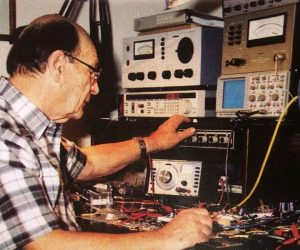AudioTechnology Advertising Example
It’s been 50 years since John Storyk first designed Electric Lady Studios for Jimi Hendrix. With over half a century of skin in the game, Storyk talks about what’s changed and what hasn’t in studio design.
I have a drawing dated February, 1969,” said John Storyk. It’s the earliest memento he can find of arguably his most famous commission; the Jimi-Hendrix-owned Electric Lady Studios in New York. The drawing doesn’t actually show a studio, rather it’s a redesign of the club, Generation, that existed on the Eighth Street premises at the time. Hendrix was a frequent performer and patron of the club, and — perhaps because of his rising bar tabs — decided to buy the lease with his manager, Michael Jefferey.
Storyk knew Generation well. A year earlier — on the day he finished college — he’d driven to Manhattan in search of his own musical fortune. He played sax and keys for a Blues band styled in The Commitments’ likeness. “We’d listen to Blues guys like Junior Wells, James Cotton and Muddy Waters at a club in New York,” he explained. The club was Generation. Thus began a long list of events that would spell Serendipity for the young Mr. Storyk.
While music wasn’t paying the bills, Storyk had to get a day job and ended up in an architecture office, which did not push his creativity to the limit. Searching for something that sounded more fun, and seeing an ad one evening while being asked to wait an extra few minutes on line for an ice cream, he answered that ad, requesting free carpentry labour for an experimental night club, downtown. It was the Summer of ’68 — “Yes, I did inhale” — when young artists like Storyk were inclined to follow their nose, rather than their wallet. He met with the owners and volunteered his labour on the condition he could redesign the club.
THINKING IT THROUGH
That club became Cerebrum. A 64-person capacity venue in New York that was a cross between a club and theatre. Not Broadway’s kind of theatre; experimental, psychedelic, dress in a white robe and dine on marshmallows, ‘you are the show’ kind of theatre.
It lasted nine months, but had a heavy cultural impact, especially on Jimi Hendrix who was looking for an architect to overhaul Generation. “It was the vibe he wanted,” said Storyk, who at 22, “got a call from Jimi Hendrix to do a club. Jimi wanted everything to have curves, and white walls with changing lights. He had this idea that at the back of the club would be a control room that could record the music played in the club. It doesn’t sound particularly complicated today. But in 1968, that sort of thing wasn’t happening.”
At the last minute, Jimi’s long-time engineer Eddie Kramer, convinced him he shouldn’t build a club. Instead, he should funnel the $3-400,000 a year he was spending on studio time to build his own. “I watched my first commission arrive and disappear in a matter of weeks,” said Storyk. However, Jimi and Eddie suggested he stay on and tackle the studio. Storyk was open about his inexperience, but they had confidence he’d figure it out. “I quit my architecture job, visited all six of the studios in New York at the time, and hired a young Phil Ramone to give us advice,” said Storyk. He and Kramer plowed through the project, scouring the scant resources available. He even offered his services free of charge to an acoustician who specialised in radio stations so he could learn how to draw and create architectural isolation details — super required for the studio’s infrastructure. 15 months later Electric Lady studios opened. Storyk adds “…these were amazing days — drawing, building the studio in the day, continuing my graduate education at night at Columbia, studying with Buckminster Fuller down the street during the summer of 69; Woodstock Festival; music everywhere….”
LADY LUCK
“It wasn’t until many years later that I realised we got a little lucky, especially with the ceiling,” said Storyk. “I went back and found out why the room worked so well, and it’s because of the ceiling, which looks like a flat propeller. It was partly aesthetics, and partly a half-baked notion that I shouldn’t have a parallel ceiling. I also remembered reading a little bit about membrane absorbers. They’d been used at RCA Studios and the great Kultura Studios in Moscow. I didn’t completely understand the science and took a stab at how to build it. We used very lightweight plaster and the ceiling turned out to be a giant membrane absorber, which keeps the low frequency reverb time down in the room.”
Storyk was frank: “I’m not going to lie. I had very little science to back up what I was conceiving, but Eddie and I took a shot at it and it worked out.” It wasn’t until many years later that he realised it gave Electric Lady a desirable large studio characteristic of tailing down the low frequency reverb time. It tightens up the sound, as opposed to concert halls, where you want it to tail up and bloom.
“That’s what’s doing it,” said Storyk about the studio’s ‘sound’. “It’s not Jimi Hendrix’s spirit in the walls, the coloured lighting, the fact you have to slide in a tiny door on Eighth Street, or the river that flows under the studio. All interesting stories, but the science is in the ceiling… although we all still wonder if Jimi is still with us sometimes”
STUDIO PODS
These days, Storyk’s company, WSDG, that he started with his wife Beth Walters (the W) is averaging about 40-50 studios a year. In its lifetime, WSDG has worked on thousands, along with halls, theatres, AV design, conference rooms and structural acoustics, “but the studios are still what I love”.
Lately, those studios have been getting smaller and many are specifically geared towards podcasting. ‘Small format streaming facilities’ have become more and more common.
WSDG has been designing spaces for all the big players; Audible (owned by Amazon), studios in LA and NY for Midroll (owned by Scripps), and a huge facility for Gimlet, which got bought out by Spotify for US$200m this year.
Every radio station is essentially in the streaming game now, as podcasting on demand has turned breakfast and drive-time shows into ‘anytime shows’. The variety of content and production styles could mean anything from a one-person/no-engineer facility to a four-person, fully-staffed interview setup. “In the case of Gimlet, a 45-minute Gimlet podcast could take months to make,” said Storyk. “It could have been done in 20 different segments with live people, phone interviews, and purchased material woven into the product.” Often the equipment is kluged together from off-the-shelf products not specifically tailored to podcasting, and part of WSDG’s job is to piece together high-end audio systems that can integrate phones — “not as easy as it sounds”— and be operated by a podcast producer with no engineering experience. When he saw Rode’s latest product, the Rodecaster Pro, Storyk was impressed and wondered why it had taken so long for a manufacturer to pull all those pieces together into a podcasting-specific console.
A lot of the studios also have intense isolation requirements. Gimlet’s facility features 10 tightly-packed studios, and because most of these top end facilities are in Brooklyn, Manhattan or Los Angeles, no space goes to waste. Admittedly, says Storyk, the majority of podcasting is centred around the voice, so the low frequency isolation requirements are often reduced. However, the smaller the room, the higher the frequency of the first order mode, which can often land in the speech range. Small rooms are often more complex to deal with than larger ones”.“
While you’d be forgiven for thinking a company like WSDG would only spec, bespoke, custom-designed acoustic treatment, Storyk is a fan of off-the-shelf products [see Beating the Low Frequency Trap]. He also lauds the ability that today’s modern iPhone can make 90% of the acoustic measurements we need. This is amazing! That means thousands of people can make measurements, which takes the voodoo out, and puts a little more science back into it.” Unlike some acousticians who would be happy to maintain the perception of their practice being a dark art, Storyk is pleased about the dissemination of measuring tools and the information available about acoustics. “People are getting smarter,” and Storyk applauds that. He would have killed for it when he was designing Electric Lady.













RESPONSES